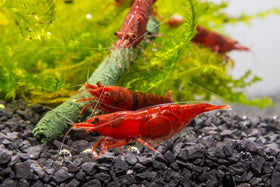
What is Aquascaping: History, Origins, and Evolution
So, what exactly is aquascaping?
Aquascaping is the art of arranging plants, rocks, and wood in an aesthetically pleasing manner within a freshwater aquarium. The aquascaper carefully selects a mix of live aquatic plants, rocks, and driftwood to create captivating underwater environments. Aquascaping enthusiasts characterize the hobby through careful curation and attention to detail.
Aquascapes can range from five-gallon desktop nano tanks to public museum exhibits holding tens of thousands of gallons of water. However big the tank, the purpose of this careful curation is to create stunning underwater environments.

As much as aquascaping is an art form, it requires a solid understanding of the natural sciences and biological processes. Aquascapes represent a delicate balance between form and function. Every element in the aquarium, living or non-living, enhances the aquarium's overall beauty and contributes to the chemical and biological balance necessary for the ecosystem's overall well-being.
A beautiful and functional aquascape works in symbiosis. Live aquatic plants and fish work together to process waste and aerate the water. An aquascape's substrate and hardscape elements also serve as surfaces for beneficial bacteria to colonize, which help neutralize ammonia toxicity and prevent parameter spikes. Lastly, the strategic arrangement of wood and rocks can affect the flow of water circulation within the aquarium.
Whether you're new to aquascaping or a seasoned scaper with a room full of tanks, keep reading to learn more about the history, origins, and evolution of modern day aquascaping as we know and love it today.
This article will go over:

The Origins of Aquascaping
Aquascaping appears to have its roots in the Netherlands during the 1930s. The Dutch were the first to pioneer the concept of a lush, garden-style aquarium with minimal hardscape.
With the Dutch style of aquascaping, aquascapers shifted their focus away from the fish, and onto growing plants. Unlike in traditional aquariums, the fish were simply an accent to the aquascape. Instead, dense and healthy plant growth became the aquascaper's primary focus. Dutch aquascapers became the first to use planted aquariums to create beautiful underwater environments, with the goal of imitating nature's beauty.
But it was the late Japanese aquascaper Takashi Amano who pioneered the modern form of aquascaping as we know it today. Amano contributed to Dutch aquascaping by weaving in elements of Japanese aesthetics and design sense to aquascaping layouts. He borrowed methodologies from Zen gardening principles and "wabi-sabi" tradition, a Japanese aesthetic philosophy that embraces imperfection and transience.
Amano created the "Nature Aquarium" style in the 1990s. It introduced the world to a purposeful way of arranging plants and rocks in a confined space to imitate natural beauty.

Takashi Amano and The Nature Aquarium Style
Amano's most significant contribution to the aquascaping hobby was the development of the Nature Aquarium style. This innovative approach aimed to create underwater landscapes that closely resembled natural, larger-scale environments.
The Nature Aquarium style explored new ways of creating aquatic environments using live aquarium plants and hardscape. This aquascaping style involves meticulous planning and adherence to precise design principles. Amano carefully selected hardscape elements and strategically arranged them to create a sense of depth and perspective within the planted aquarium.
Amano believed that plants and hardscape contributed to the health and well-being of the aquascape, in addition to structure and visual appeal. Aquascapes are a great example of the relationship between form and function. Every element of the aquascape, living or non-living, contributes to the beauty and biological processes involved in a thriving ecosystem.
Through his aquascapes, Amano explored new ways of creating captivating aquatic landscapes using live aquarium plants. He achieved this by creating illusions of landscapes in miniature through careful planning and attention to detail. Amano aimed to replicate the look of mountain ranges, grass fields, and dense forests within the confined space of an aquarium.
Amano's work proved that plants, fish, and other living organisms work together in symbiosis and contribute to a natural and self-sustaining ecosystem. His design principles and methodology served as a pillar that has shaped modern-day aquascaping as we know it today.

The Evolution of Aquascaping Techniques and Principles
Building upon Amano's pioneering work, aquascaping techniques have since evolved over the years. Hobbyists worldwide have come up with different types of aquascapes and adopted various approaches to creating captivating underwater landscapes. A few styles and layouts have grown in popularity and have become widely recognizable in the hobby.
A few of the most popular aquascaping styles are:
- The Dutch Style: The Dutch aquarium focuses on the growth and arrangement of many types of plants, particularly stem plants. Lush and densely planted arrangements characterize this style. Aquascapers also emphasize precise plant selection and nutrient management. When maintained, these tanks are colorful, and vibrant, and showcase a densely planted, rich tapestry of aquatic plants.
- The Iwagumi Style: The Iwagumi aquascape is simple yet impactful. It features a few rocks surrounded by a dense carpet, such as Dwarf Hairgrass or Monte Carlo. The goal of this style is to create a calm and peaceful space. The main focus is on the natural beauty of the stones, without any distractions.
- The Biotope: The Biotope, also known as the "jungle-style" aquascape, seeks to recreate the look of a naturally-occurring habitat within an aquarium. This style attempts to celebrate nature's diversity and creates a tribute to its beauty. Hobbyists mimic a specific region's environment in the aquascape for aesthetic accuracy and to raise awareness for ecology and conservation.

The Role of Technology in Modern Aquascaping
Advancements in technology have played a significant role in shaping the modern landscape of aquascaping. Thanks to key innovations in aquascaping product development, many hobbyists take advantage of highly specialized tools to maximize their aquascaping potential. Specialty plant-growing lighting rigs and advanced CO2 injection systems are some of the products that have hit the market. Fertilization products designed to address specific plant nutrient deficiencies also help enhance the natural appearance of growing plants.
Aquascaping, as much as it is an art, also requires basic knowledge of biological processes and water chemistry. Aquarium lighting is one example of this need for both form and function. Sophisticated LED lighting systems offer precise control over color temperature and intensity, allowing aquarists to create optimal lighting conditions for plant growth. Similarly, advances in filtration equipment provide efficient water purification, which helps maintain optimal water parameters for live plants and fish.
Additionally, advancements in CO2 injection systems and fertilization methods have led to improved plant growth for hobbyists worldwide. While plant growth in freshwater plants like Java Fern and Amazon Swords is possible in low-tech setups, key technological advances in the hobby make it possible for hobbyists to grow and enjoy more difficult plants. Injection systems supplement the aquarium with a consistent supply of carbon dioxide, which helps plants photosynthesize more efficiently. This leads to increased oxygen production, denser plant growth, and improved overall ecosystem health.

The Future of Aquascaping
The growing popularity of aquascaping has given rise to a vibrant, global community of passionate enthusiasts. Amano's work showed how plants, fish, and other organisms can live together in a natural and self-sustaining ecosystem.
Free access to forums and social media platforms now allows aquascapers worldwide to connect, learn, and inspire each other. These groups promote shared ideas, advice exchange, and continued support to hobbyists of all skill levels. It's now easier than ever for aquascapers to connect and continue pushing the limits of this captivating art form.
The aquascaping hobby also enjoys an active and vibrant local scene. Aquascaping competitions showcase awe-inspiring works of art, each with its own unique design and theme. Advanced hobbyists actively participate in these competitions, fostering creativity and healthy competition while promoting the sharing of industry knowledge and expertise.
As aquascaping continues to gain recognition and popularity, the future holds exciting possibilities. Future technological advancements will offer even more efficient and sustainable methods for creating and maintaining underwater landscapes.

Final Thoughts on Aquascaping
The hobby's unique blend of artistic design and biology expertise transforms simple planted tanks into mesmerizing underwater scenes. As the hobby grows and evolves, aquascapers around the world will continue to draw inspiration from the world around them.
Through dedication, imagination, and a deep understanding of how ecosystems function, aquascapers transform simple freshwater tanks into mesmerizing aquatic worlds that captivate and inspire generations to come.

Tell us - Was this article helpful? Please leave a comment below!
If you have any questions regarding this article, please email support@buceplant.com, or DM us on Instagram or Facebook so we can assist you directly - @buceplant





Leave a comment